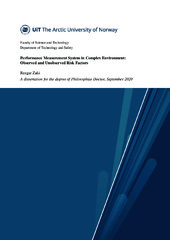Performance Measurement System in complex environment: observed and unobserved risk factors
Permanent link
https://hdl.handle.net/10037/19902Date
2020-12-04Type
Doctoral thesisDoktorgradsavhandling
Author
Zaki, RezgarAbstract
World demand for energy leads industry to harvest energy in complex environment with harsh conditions and sensitive areas, such as the Arctic region – one of the last remaining wild places in the world – with potentially harmful consequences. Moreover, over the past few decades, the increasing trend of melting sea ice in the Arctic has provided increased access and has created new opportunities for economic development within metals and minerals, fisheries, cargo shipping, cruising, subsea telecom cables and pipelines. However, development of the Arctic resources is assumed to be technologically and economically challenging and risky. Studies reveal that, due to low temperatures, sea ice, polar low pressures, poor visibility, seasonal darkness limitations to the logistics of supplies, etc., Arctic operational conditions have significant effects on the performance of components and industry activities in various ways, including increasing failure rate and repair time, and can cause different types of production losses. The optimal functioning of technical systems involved in design and operation in the Arctic faces numerous challenges, in order to succeed in a globally competitive market with limited resources. The concept of the Performance Measurement System (PMS) is frequently used by industries and has been shown to be an essential concept for improving efficiency and effectiveness and supporting the design, planning, and managing of a company; PMS refers to output results obtained from a system that permits evaluation and comparison, relative to past results or other companies. PMS needs up-to-date and accurate performance information on its business. This performance information needs to be integrated, dynamic and accessible, to assist fast decision-making. However, performance terminologies and standards for the Arctic reveal that the Performance Indicators (PIs) measured by industries though important, are not enough and could still be improved by identifying more important indicators, which contribute to a successful PMS in the Arctic. Hence, the development and continuous improvement of PMSs and the identification of more PIs for judging performance of equipment in the Arctic are critical for industry success. Moreover, the quantification of performance is complex, as it involves various indicators with different perspectives at various hierarchical levels. The lack of correct sources of information and data on PIs and suitable statistical models and standard approaches are a barrier to the successful quantification of PIs. Operation and maintenance data are often collected from multiple and distributed units in different operational conditions, which can introduce heterogeneity into the data. Part of such heterogeneity can be explained by the observable risk factors, whose values and the way that they can affect the item’s PIs are known. However, some factors which may affect PIs are typically unknown (unobserved risk factors), leading to unobserved heterogeneity. Nevertheless, many researchers have ignored the effect of observed and un-observed risk factors, and this may lead to erroneous model selection, as well as wrong conclusions and decisions. The statistics models must be able to quantify the effect of observed and unobserved risk factors on PIs and must be built based on correct assumptions that reflect the operational conditions.
In this thesis, a methodology for the monitoring and analysis of operation and maintenance performance is developed. The aim is to facilitate improvements and the optimization of decision-making for operation and maintenance in the Arctic. Firstly, a brief survey of technological and operational challenges in the Arctic region, from a performance point of view, is presented. Further, appropriate performance indicators/criteria that need to be measured for judging the performance of equipment/systems in the Arctic that contribute to a successful PMS will be discussed. Thereafter, the study focuses on improvement and modifying the available statistical approach for the prediction of PIs, considering the effect of observed and unobserved risk factors.
Has part(s)
Paper A: Barabadi, A., Zaki, R. & Garmabaki, A.H.S. (2016). Designing for performability: An icing risk index for Arctic offshore. Cold Regions Science and Technology, 124, 77-86. Also available at https://doi.org/10.1016/j.coldregions.2015.12.013.
Paper B: Zaki, R., Barabadi, A. & Nouri Qarahasanlou, A. Observed and unobserved heterogeneity in failure data analysis: A case study. (Submitted manuscript).
Paper C: Zaki, R., Barabadi, A., Garmabaki, A.H.S. & Nouri Qarahasanlou, A. (2019). A mixture frailty model for maintainability analysis of mechanical components: a case study. International Journal of Systems Assurance Engineering and Management, 10(6), 1646-1653. Also available at https://doi.org/10.1007/s13198-019-00917-3. Accepted manuscript version available in Munin at https://hdl.handle.net/10037/17895.
Publisher
UiT Norges arktiske universitetUiT The Arctic University of Norway
Metadata
Show full item recordCollections
The following license file are associated with this item:


 English
English norsk
norsk
